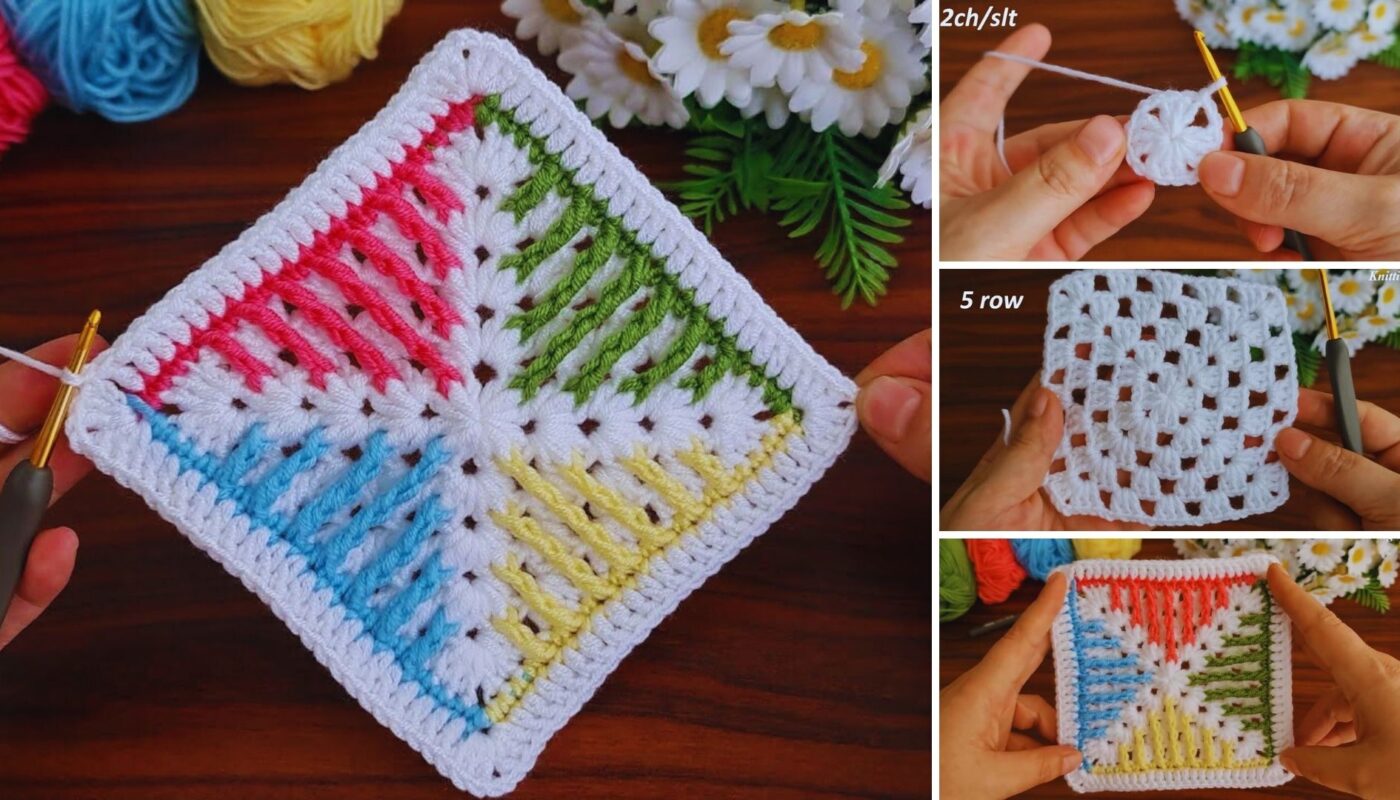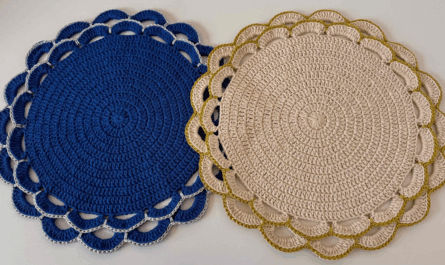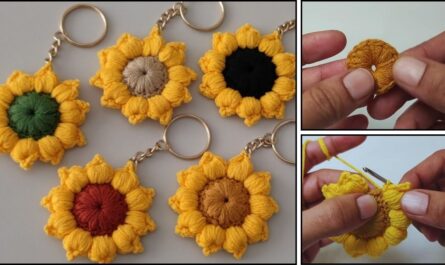Let’s create an absolutely adorable and eye-catching crochet baby blanket square! This isn’t just a simple granny square; we’ll focus on a design that truly pops with texture, color, and a delightful pattern, making it a cherished heirloom or a standout gift. You can make several of these squares and then join them together to form a full blanket, or simply make one large square for a smaller stroller or tummy-time mat.
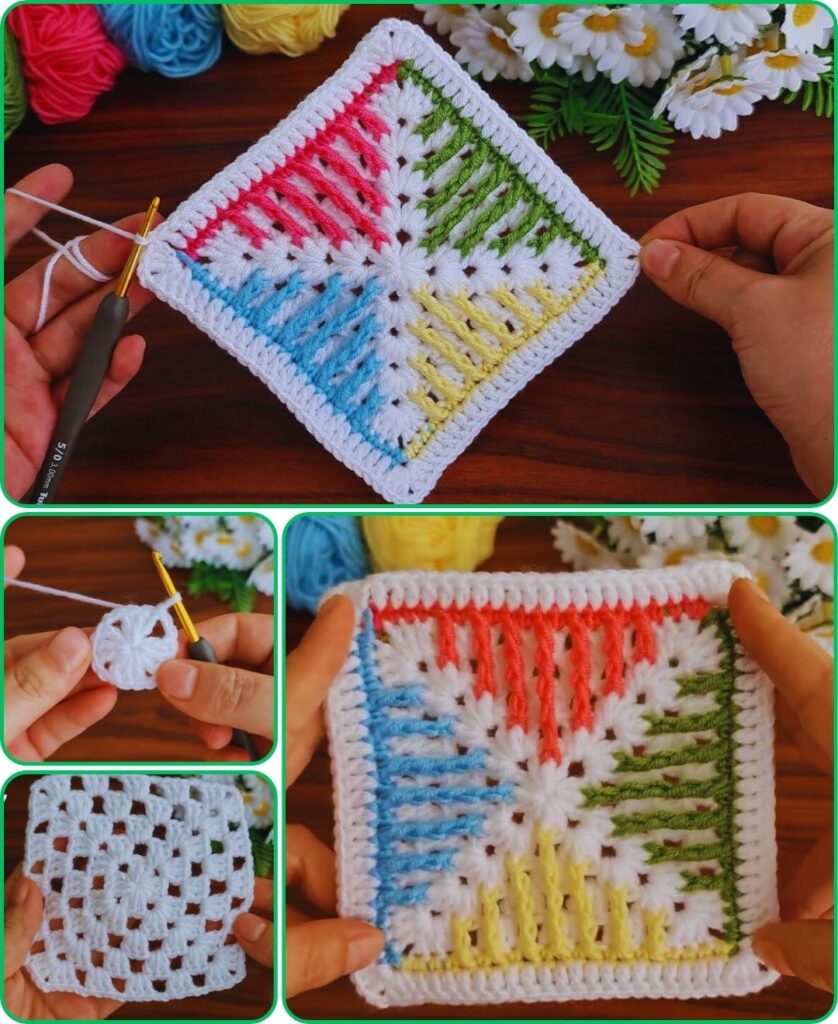
How to Make an Eye-Catching Crochet Baby Blanket Square: Detailed Tutorial
This pattern will guide you through creating a textured, multi-layered square that’s both beautiful to look at and wonderfully soft for a baby. We’ll use a combination of basic and slightly more advanced stitches to achieve a rich, appealing design.
Skill Level: Intermediate
You’ll need to be comfortable with:
- Chain (ch): The basic foundation.
- Slip Stitch (sl st): For joining rounds and neatening.
- Single Crochet (sc): A compact stitch.
- Half Double Crochet (hdc): A medium-height stitch.
- Double Crochet (dc): A taller stitch.
- Front Post Double Crochet (fpdc): Creates a raised texture.
- Back Post Double Crochet (bpdc): Creates a raised texture.
- Popcorn Stitch (PC): Creates a delightful bobble texture.
- Working in rounds: Crocheting in a circular motion.
- Increasing: Adding stitches for shaping.
- Magic Ring (MR) or Adjustable Ring: Highly recommended for a tight center.
- Basic color changes.
- Weaving in ends neatly.
Finished Square Dimensions (Approximate):
This pattern typically creates a square about 8×8 inches (20×20 cm). You can adjust the size by using different yarn weights and hook sizes, or by adding more rounds to the pattern (ensuring you maintain the stitch count increases for a square).
Materials You’ll Need:
- Yarn: Approximately 50-70 yards (45-64 meters) per square of Worsted Weight (Medium #4) Yarn.
- Recommended: Choose soft, baby-friendly yarns. Acrylic, cotton blends, or superwash merino wool are excellent choices as they are typically machine washable and gentle on baby’s skin.
- Colors: To make it “eye-catching,” choose 2-4 complementary or contrasting colors. For example:
- Color A (Center/Popcorns): A bright pop of color.
- Color B (Background/Texture): A calming, neutral tone.
- Color C (Accent/Border): A contrasting or harmonious color for definition.
- Crochet Hook: Size H/5.0mm. This is a versatile hook size for worsted weight yarn. If your stitches are too tight, go up a size; if too loose, go down. Aim for a fabric that’s soft and pliable, not too stiff.
- Yarn Needle (Tapestry Needle): Essential for weaving in all those loose ends for a professional finish.
- Scissors: For cutting yarn.
- Stitch Markers (Optional but Recommended): Useful for marking corners, especially in earlier rounds, to help maintain the square shape.
Gauge:
For a blanket square, gauge is somewhat flexible, but consistency is key. Aim for your square to be relatively flat and even. If your square is cupping, you might need more increases or a larger hook. If it’s ruffling, you might need fewer increases or a smaller hook.
Abbreviations Used in This Pattern:
- ch: chain
- sl st: slip stitch
- sc: single crochet
- hdc: half double crochet
- dc: double crochet
- tr: treble crochet
- fpdc: front post double crochet (yarn over, insert hook from front to back around post of stitch, yarn over, pull up loop, [yarn over, pull through 2 loops] twice)
- bpdc: back post double crochet (yarn over, insert hook from back to front around post of stitch, yarn over, pull up loop, [yarn over, pull through 2 loops] twice)
- PC: popcorn stitch (work 5 dc in the same stitch, remove hook from loop, insert hook into top of first dc of the 5-dc group, pick up dropped loop, pull through, ch 1 to secure)
- st(s): stitch(es)
- sp: space
- ch-sp: chain space
- MR: Magic Ring (also called Magic Circle or Adjustable Ring)
- rep: repeat
- FO: Fasten Off
- (): repeat instructions within parentheses a specified number of times.
- []: indicates the total number of stitches and/or chain spaces at the end of a specific round.
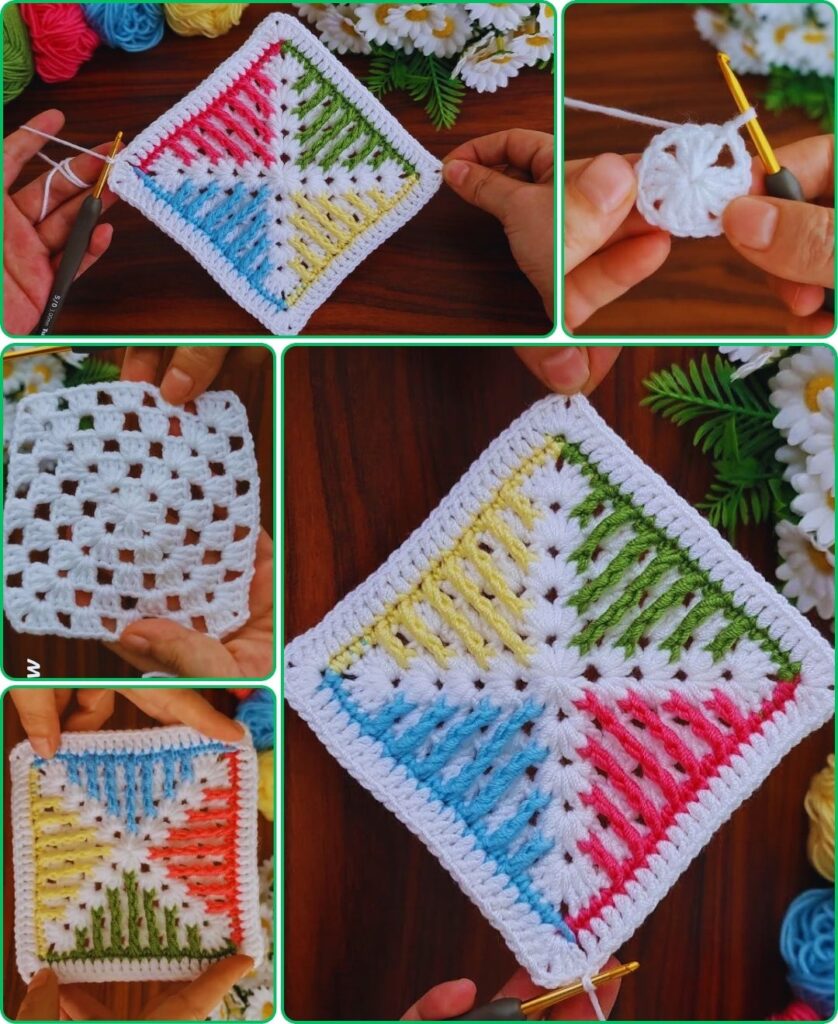
How to Make it Eye-Catching:
- Texture: Using stitches like Popcorns and Post Stitches (fpdc/bpdc) creates a wonderful tactile surface that babies love to explore.
- Color Placement: Strategic color changes can highlight different sections and make the patterns pop.
- Defined Corners: Clear, well-formed corners are essential for a beautiful square.
Let’s Crochet Your Eye-Catching Baby Blanket Square!
We’ll start from the center and work outwards, shaping the square as we go.
Part 1: The Center & First Layer (Color A)
- Start: Make a Magic Ring (MR).
- Alternative Start: Chain 4, then sl st into the first chain to form a ring.
- Round 1:
- Ch 2 (does NOT count as a stitch).
- Work 12 dc into the MR (or into the center of your ch-4 ring).
- Pull the tail tightly to close the center hole.
- Sl st into the top of the first dc to join the round.
- [12 dc]
- Round 2 (Popcorns!):
- Ch 2 (does NOT count as a stitch).
- (Work PC (Popcorn Stitch) in the first stitch, ch 1). Repeat from * to * into each of the 12 dc stitches around.
- Sl st into the top of the first PC to join the round.
- [12 PC, 12 ch-1 sps]
- Fasten off (FO) Color A, leaving a 6-inch tail.
Part 2: Shaping the Square & Texture (Color B)
This is where we begin to define the square shape and add more texture.
- Join Color B: Join Color B with a sl st into any ch-1 space from Round 2.
- Round 3 (Creating Corners):
- Ch 2 (does NOT count as a stitch).
- In the same ch-1 space, work 2 dc.
- In the next ch-1 space, work 3 hdc.
- In the next ch-1 space (this will be your first corner!), work (3 dc, ch 2, 3 dc).
- In the next ch-1 space, work 3 hdc.
- In the next ch-1 space, work 3 dc.
- In the next ch-1 space (your second corner!), work (3 dc, ch 2, 3 dc).
- In the next ch-1 space, work 3 hdc.
- In the next ch-1 space, work 3 dc.
- In the next ch-1 space (your third corner!), work (3 dc, ch 2, 3 dc).
- In the next ch-1 space, work 3 hdc.
- In the last ch-1 space (your fourth corner!), work (3 dc, ch 2, 3 dc).
- Sl st into the top of the first dc to join the round.
- [12 groups of 3 stitches + 4 ch-2 corner spaces. Total of 36 stitches if you count them all individually within the groups, excluding chains.]
- Round 4 (Post Stitch Texture):
- Ch 2 (does NOT count as a stitch).
- (Work fpdc around each of the next 3 stitches (these are a 3-stitch group from the side of Round 3). Work bpdc around each of the next 3 stitches. When you reach a corner ch-2 space, work (2 dc, ch 2, 2 dc) in the space).
- Repeat from * to * around the square. You’ll alternate between 3 fpdc and 3 bpdc groups on the sides of the square, and always work (2 dc, ch 2, 2 dc) in the corners.
- Sl st into the top of the first fpdc to join.
- [4 sides, each with 3 fpdc, 3 bpdc, 3 fpdc (or reversed sequence) for a total of 9 post stitches per side, plus 4 corner sets of 4 dc stitches. Total 36 post stitches and 16 corner dc stitches.]
- Fasten off (FO) Color B, leaving a 6-inch tail.
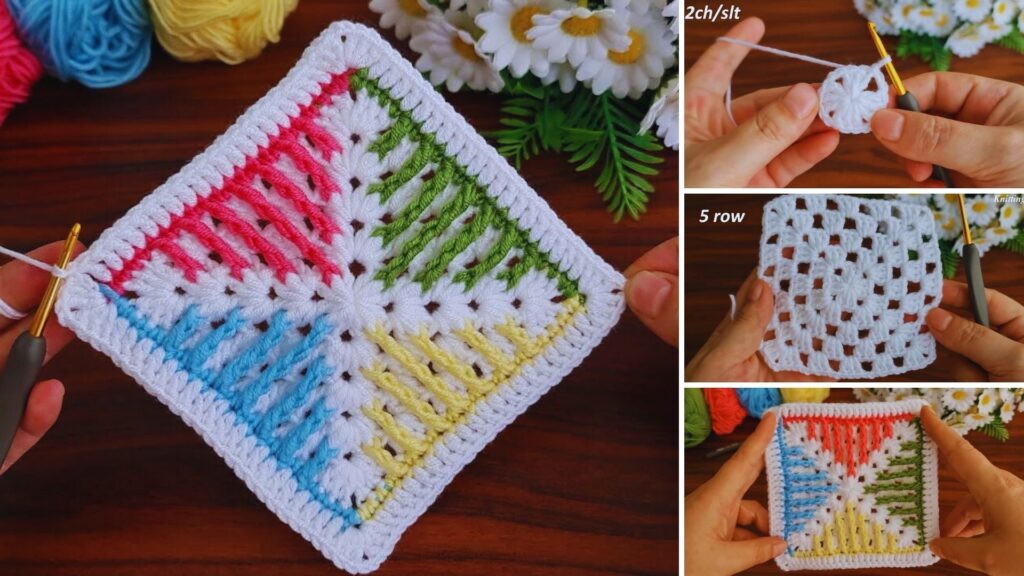
Part 3: Expanding & Defining (Color C)
Let’s add another layer with a new color for definition.
- Join Color C: Join Color C with a sl st into any ch-2 corner space from Round 4.
- Round 5 (Simple DC Expansion):
- Ch 2 (does NOT count as a stitch).
- In the same corner ch-2 space, work (2 dc, ch 2, 2 dc).
- Work dc in each stitch along the side until you reach the next corner ch-2 space. (You’ll be working into the tops of the fpdc and bpdc stitches from Round 4, and the 2 dc stitches from the previous corner.)
- Repeat from * to * around the square (work (2 dc, ch 2, 2 dc) in each corner, and dc in each stitch along the sides).
- Sl st into the top of the first dc to join.
- [Each side will have 17 dc stitches + 4 ch-2 corner spaces. Total 68 dc stitches.]
- Round 6 (Optional Border/More Texture):
- Ch 1 (does NOT count as a stitch).
- In the same corner ch-2 space, work (1 sc, ch 2, 1 sc).
- Work sc in each stitch along the side until you reach the next corner ch-2 space.
- Repeat from * to * around the square (work (1 sc, ch 2, 1 sc) in each corner, and sc in each stitch along the sides).
- Sl st into the top of the first sc to join.
- Fasten off (FO) Color C, leaving a 6-inch tail.
Part 4: Finishing Your Eye-Catching Square
- Weave in All Ends:
- This is an extremely important step for a professional, durable, and truly “eye-catching” finish. Thread each yarn tail onto your yarn needle.
- Carefully weave them into the stitches of the same color on the back side of your square. Try to go through the middle of the stitches to fully hide the tails. Weave in one direction for a few stitches, then change direction slightly and weave back for a few stitches (this “locks” the tail in place and prevents it from unraveling).
- Take your time with this step, as neatly woven ends make a huge difference in the final appearance.
- Block Your Square (Highly Recommended!):
- Blocking is essential for any granny square project, especially for ensuring uniform size and straight edges when joining multiple squares.
- Method 1 (Wet Blocking): Gently wet your square (you can spritz it or fully submerge it and gently squeeze out excess water). Lay it flat on a foam blocking mat or a towel. Pin it to your desired dimensions (e.g., 8×8 inches), ensuring the corners are sharp and the sides are straight. Let it air dry completely.
- Method 2 (Steam Blocking): Lay your dry square flat on a blocking mat or heat-safe surface. Hover a steamer or an iron on a low, steam setting over the square without touching the fabric. As the steam relaxes the fibers, gently pull and pin the square to your desired dimensions. Let it cool and dry completely.
- Caution: Be careful not to overstretch or overheat acrylic yarn, as it can “kill” the fibers and make them limp.
You’ve now created a beautiful and eye-catching crochet baby blanket square! You can make many more of these in various color combinations, then join them together using a simple whip stitch, slip stitch join, or a join-as-you-go method to create a full baby blanket.
What color combination are you excited to try for your first square?
